How to Ask for a Testimonial From A Client Not Being Pushy?
By Nicolas Jacobeus on November 6, 2024

|
TL;DR:
|
|---|
Ever had that moment when you’re staring at your email, fingers hovering over the keyboard, wondering exactly how to ask a client for a testimonial? Your work was solid, they seemed happy, and you know a testimonial would work wonders for your credibility.
But here you are, hesitating, worried you’ll sound too pushy, too formal, or worse, desperate.
I've been there. We all have. And guess what?
Most clients are actually open to giving testimonials. They just need a little nudge… but the right kind of nudge.
In 2025 (and well beyond it), testimonials are gold. They’re not just words on a page; they’re trust, they’re proof, and they’re often the deal-makers.
So, how do you ask without feeling awkward? How do you actually get one, one that’s authentic, compelling, and works like magic for your brand?
I’ve got you.
In this guide, I’ll break down real-life strategies of how to ask for a testimonial the right way, word-for-word templates, and tips that have worked for me and many others. Let’s make asking feel less weird and more… well, effective.
So, what is a testimonial, really?
What exactly is a testimonial?
Short fact: It’s not some stuffy corporate statement or a forced “This product is amazing!” kind of thing.
A testimonial is like a mini-story, your unique short piece of content, told by real people, that showcases what makes your business awesome through their personal experiences. Think of it as a way to let others speak for you, sharing what it’s really like to work with you or use what you’re offering.
But it doesn’t have to be fancy or super long. In fact, the best testimonials are often short, specific, and clear.
They answer questions like: What was the problem? How did you help solve it? And what was the result? If your customer can nail those points in a few sentences, you’ve got a powerful testimonial that’ll do some heavy lifting.
Imagine it this way: A testimonial is like a friend giving you a solid recommendation for a movie. You’re way more likely to try it out after hearing their honest feedback than you would after reading an ad.
Amoobi, one of our retail tech clients, had a great story to tell, but needed help telling it. Check this out to get a better idea.
 Note
Note
That’s the kind of vibe we’re going for here: real, relatable, and a little spark of excitement!
“Why do people go nuts over testimonials?” you might ask. I have the answer.
Why do testimonials even matter?
What makes a few short sentences from a happy customer more persuasive than an entire marketing campaign?
Let’s break it down. Because once you understand the psychology behind testimonials, you’ll never skip asking for one again.
1. Testimonials are a trust shortcut
Here’s the thing: client testimonials are like a trust shortcut. They show your potential clients that real people, just like them, have had a great experience with your business. They let people know, “Hey, this actually works!”
2. They cut through marketing skepticism
Let’s be honest. We’re all a little skeptical of marketing these days. Everyone claims they’re the best, that they’ll change your life, that their product will solve all your problems.
But when someone else, a real customer, tells you they’ve had a great experience, it feels way more believable. It’s like getting a recommendation from a friend.
Suddenly, that product or service feels safer, more genuine.
3. They make your business more relatable
Testimonials also do something pretty magical: they make your business more relatable. They show how you’ve helped real people with real issues (like your SaaS blog, no doubt). Potential customers can see themselves in these stories and think, “If it worked for them, it could work for me, too.”
It’s a way of saying, without all the marketing fluff, that you actually deliver results.
4. They’re quick and easy to consume
Plus, customer reviews and testimonials are quick and easy for people to process. They don’t need to wade through pages of text or watch a long video, they get the story in just a few sentences. And that’s all it takes to get someone intrigued and feeling a little more confident about giving you a try.
Testimonial vs. case study: what’s the real difference?
So, testimonial or case study? Aren't they kind of the same thing?
Not quite. They both tell your story from the customer’s point of view, but they do it in very different ways.
|
Testimonial |
Case Study |
|---|---|
|
Quick, punchy, and straight to the point |
The full story, deep dive format |
|
A snapshot of a customer’s experience, usually a few sentences or a short paragraph |
A step-by-step journey: problem → process → solution → results |
|
Easy to read, easy to trust, perfect for social proof |
Often includes stats, visuals, quotes, and detailed context |
|
Think of it as the highlight reel: “This product helped me do XYZ!” |
Think of it as the documentary: a deep dive into how your product/service made a meaningful impact |
|
Gets to the heart of why someone loves what you do |
Shows how you helped them overcome a challenge or reach a goal |
|
Easier to collect and share |
Takes more time and effort to produce, but packs more punch |
|
Like your friend at a dinner party saying, “Oh, I worked with them! They’re awesome, totally fixed my problem.” |
Like your friend saying, “So I had this huge issue, and here’s exactly how they helped me fix it...” |
So, which should you use?
Both. Testimonials are the gateway; they spark curiosity. Case studies close the loop. Together, they create a full picture of trust, results, and real-world value.
Wondering why we’re the case study pros? We know how to make your results pop and connect with clients!
Now that you know the “why,” here’s a simple, step-by-step guide on how to actually ask for testimonials (with how to ask for reviews, plus examples and templates).
How to ask for a testimonial from a client? [step-by-step guide]
Alright, we know why testimonials matter, but… how to request a testimonial from a client? It can feel a bit awkward at first, but don’t worry!
With a few simple steps, you’ll see it’s easier (and way less weird) than you think.
1. Pick the right moment
Timing is everything when it comes to asking for a testimonial.
Ask too early, and your customer might not have felt the full impact of what you offer. Wait too long, and they might have moved on or forgotten the best parts of their experience.
So, when’s the sweet spot? Here are a few golden moments:
a. Right after they hit a big win
Did they just reach a milestone, like automating their first workflow, sending a successful campaign, or hitting their first 1,000 users?
This is it, the golden moment. They’re pumped, they’re seeing value, and they’re already thinking, “This tool is amazing!”
Catch them in this happy zone and ask if they’d be open to sharing how your platform made it happen.
b. After a smooth onboarding
Once users complete onboarding and start using your tool like pros, they’ll be feeling the love. They’ve made it past setup, know their way around, and are seeing early results.
Send a friendly nudge: “Hey! Now that you’re all set up, would you be cool with sharing a few thoughts on how it’s going?”
You’re catching them while the experience is still fresh, and, ideally, positive.
c. After they upgrade or renew
If a user just upgraded their plan or renewed their subscription (or any other sales funnel milestone they’ve achieved), it’s a big sign they’re happy. They trust you enough to stick around or commit more.
Right after that upgrade, pop the question: “Thanks for upgrading! Would you be up for telling others why you’re sticking with us?”
They’re already in “yes” mode, so this ask feels natural.
d. After positive feedback or a great support interaction
Sometimes users will drop you little gems, like an email saying, “Hey, this feature rocks!” or “Your support team saved the day!”
Don’t let that go unnoticed!
Jump in with a quick, casual reply: “So glad you’re loving it! Mind if we turn that into a quick testimonial?” They’re already hyped, so they’ll likely say yes.
e. When you’ve just launched a feature they love
Rolled out something new that’s getting all the love? Maybe it’s a feature users have been asking for, and they’re thrilled it’s here. This is a prime time to reach out!
When customers see that you’re listening and evolving, they feel more connected to your brand. Ask if they’d be open to sharing a quick blurb about the new feature and how it’s helping them.
It’ll capture their excitement and show others that you’re constantly improving.
2. Keep it personal and casual
When you’re wondering how to get a testimonial from a client, ditch the formality.
People respond better when it feels like a real conversation, not a corporate request. Instead of a stiff, "We would appreciate your feedback on our product," try something that sounds more like you’re talking to a friend.
For example:
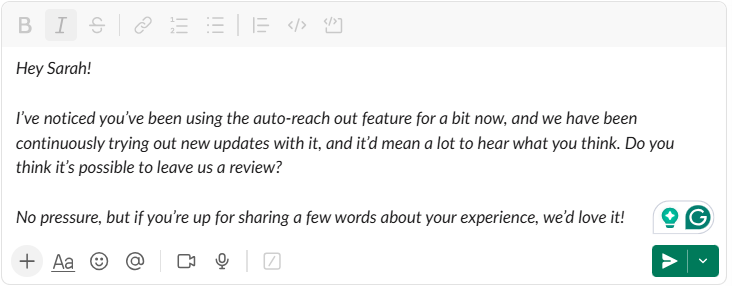 Or even simpler:
Or even simpler:
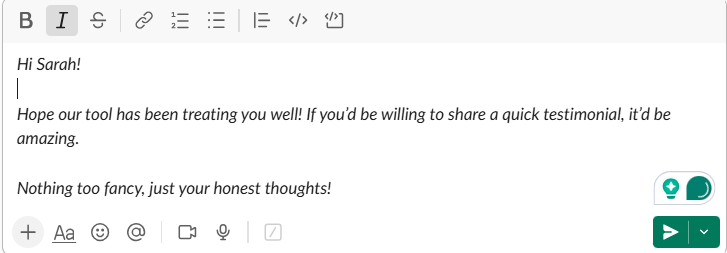 Keeping it personal shows you value their unique perspective. It doesn’t feel like a mass email; it feels like you genuinely want to hear from them.
Keeping it personal shows you value their unique perspective. It doesn’t feel like a mass email; it feels like you genuinely want to hear from them.
And that little touch of casual friendliness makes it more approachable, because nobody wants to write a testimonial that feels like homework.
3. Make it easy with prompts or examples
Sometimes, people freeze up when asked to write a testimonial. Help them out! Give them a few prompts or examples to get the wheels turning. This way, they’re not staring at a blank page thinking, “Where do I even start?”
Here is how to ask a customer for a review, to ease the process:
“You could mention what problem you were trying to solve, how [Product/Service] helped, or even your favorite feature. Totally up to you!”
Or:
“If you’re stuck, here’s a quick example from another user: ‘[Product/Service] made my life so much easier by helping me [specific result].’”
These little nudges make it easier for them to organize their thoughts. Plus, it helps them feel confident that they’re sharing exactly what you’re looking for.
Just a few prompts can go a long way in making the whole thing feel simple and doable.
4. Offer different formats (written, video, audio)
When it comes to testimonials, variety is your friend.
So, how to ask a customer for a testimonial for different formats?
Not everyone likes to write, and not everyone’s comfortable on camera. By giving options, you’re making it easier for people to share their experience in a way that feels natural.
Here’s how to approach each format:
a. Written testimonials
This is the classic go-to. Written testimonials are quick and easy for most people, and they’re perfect for putting on your website, landing pages, or even in emails.
When asking for a written testimonial, keep it casual:
“If you’re up for it, would you mind sharing a few words about your experience with [Product/Service]? Just a sentence or two on what you liked or found helpful would be awesome!”
Written testimonials are versatile, easy to highlight on your site, and can even be sprinkled into case studies or marketing materials.
They’re short, sweet, and impactful!
b. Video testimonials
Video is powerful, people trust seeing a real face talking about your product. But for a lot of people, being on camera can feel intimidating, so approach it gently.
Here is how to get video testimonials from customers, easy way:
“If you’re open to it, a quick video of you sharing your experience would be amazing! Nothing fancy, just you talking about what you like or how [Product/Service] has helped you.”
With video testimonials, keep it low-key. Let them know they can just use their phone or webcam, no need for pro lighting or fancy editing. Once you get the video, you can use it in ads, on social media, or embed it on your site for that extra bit of authenticity.
Video testimonials feel personal and relatable, and they make a big impact.
c. Audio testimonials
For those who might not love writing or being on video, an audio testimonial is a great middle ground. It’s super easy for them to record a voice message, and you can use it creatively on your site or even in podcasts or videos.
“If writing or video isn’t your thing, would you be up for recording a quick audio message? Just a minute or so about what you like most about [Product/Service]. You can record it straight from your phone, super easy!”
Audio testimonials are a fresh way to mix up your content. You can share them as clips on social media, add them to product demos, or even use them in customer success stories.
They’re quick for customers to record, and you get that genuine voice coming through.
Want to impress your clients? Let us create a standout case study for you; they’ll love it!
5. Highlight why their feedback matters
Sometimes people need a little reminder of why their words are valuable.
Let them know that their feedback isn’t just a nice-to-have, it’s a big deal! People want to feel like they’re making a difference, so make it clear how their testimonial helps.
Try saying something like:
“Your feedback would really help other people decide if [Product/Service] is right for them. Hearing real stories from real users makes such a difference!”
Or, use this “leave us a review” template:
“We could talk about how great [Product/Service] is all day, but it means way more coming from someone who’s actually using it.”
When they understand that their testimonial could be the reason someone else takes the leap, they’re way more likely to give it.
It makes them feel part of the bigger picture and shows that their experience has real value to others.
6. Follow up politely if there's no response
Life gets busy, and sometimes your first ask slips through the cracks. Don’t sweat it! A polite, friendly follow-up can go a long way.
Keep it light, no pressure, and give them an easy way to jump back in.
Try something like:
“Hey [Name]!
Just circling back in case my last message got buried. If you’re still open to sharing a quick thought about [Product/Service],
I’d be so grateful! No rush, just whenever you’ve got a minute.”
Or even a little humor:
“Friendly nudge in case my last email got lost in the inbox jungle! Still would love to hear your thoughts if you’re up for it.”
Following up shows you’re genuinely interested, not just sending mass messages. And by keeping it low-key, you’re respecting their time. Sometimes that second nudge is all they need to remember and finally hit “reply.”
7. Use specific project highlights as a reminder
If a user worked with you on something specific, remind them of that success! It gives context, sparks their memory, and helps them focus on what to talk about.
You could say:
“Remember that project where we boosted your [specific metric, like conversions or productivity]? It’d be amazing if you could share a quick thought on how [Product/Service] helped with that.”
Or something like that:
“Hey [Name]!
Thinking back to [specific feature they used], it’d be awesome to hear your take on how it made a difference.”
When you reference a specific win or feature, it’s easier for them to respond. They’re not trying to think of something out of thin air, you’ve given them a clear direction.
Plus, it makes their testimonial feel more authentic and detailed, which others will love.
8. Keep it short and straightforward
Let’s be real, nobody wants to write an essay.
When you’re asking for a testimonial, keep it short and sweet. Make it clear they don’t need to spend ages on this; just a few honest words will do the trick.
Try something like:
“It doesn’t need to be long! Just a couple of sentences about what you like or what’s been helpful would be awesome.”
Or, here is how to ask a client for a testimonial, sweet and short:
“Don’t stress about writing a novel, just a quick note on your experience with [Product/Service] would be perfect!”
By keeping the ask low-pressure, you’re making it easier for them to say yes. When they know it’s just a quick task and not a whole writing project, they’re more likely to knock it out right away.
Simple, short, and straightforward, that’s the magic combo.
9. Offer a draft if they’re comfortable with it
Sometimes people freeze up just thinking about what to say. Offering to draft something for them can be a total game-changer. It takes the pressure off, and they can tweak it to make it their own.
You could say:
“If it helps, I’d be happy to draft a few sentences for you to review and change however you like!”
Or even:
“No worries if you’re busy! I can write something up for you to approve. Just let me know!”
This approach keeps things super easy for them. They get the option to skip the heavy lifting while still giving their feedback. It’s a quick way to get the testimonial done, and you’ll have something polished and ready to go.
10. Express genuine gratitude
When someone takes the time to give you a testimonial, show them some real appreciation! It might seem simple, but a heartfelt “thank you” goes a long way. Let them know that their feedback isn’t just useful, it genuinely means a lot to you.
Try something like that (this is my way of how to ask for customer testimonials, being really thankful):
“Thank you so much for sharing this! It really helps us, and we’re so grateful for your support.”
Or, use this one:
“Can’t thank you enough for doing this! Your feedback means the world to us, seriously.”
This isn’t just about getting a good testimonial; it’s about building a relationship. People love to feel valued, and when you make it clear how much you appreciate their time, it strengthens that connection.
Plus, they’ll be more likely to help out again in the future!
11. Make it clear where you’ll share their testimonial
People like to know where their words (or face!) will end up. Let them know exactly where you plan to share their testimonial so there are no surprises.
It also makes them feel like their feedback has a real purpose.
You could say:
“We’d love to feature your feedback on our website and maybe sprinkle it in our social media too!”
Or, here is one more alternative:
“Your testimonial would be perfect on our homepage, helping other folks understand what we’re all about!”
When they know where it’ll be showcased (and you know it as well, it should be a part of your content strategy), they’re more likely to put thought into it and feel comfortable knowing exactly how it’ll be used.
Plus, they might get a little excited about seeing their own words in action!
Testimonials are cool, but let’s level up. We’ll turn client feedback into a powerful case study that shows real impact.
12. Offer a testimonial swap if they also need one
If your client or user also runs a business, why not suggest a testimonial swap? It’s a win-win: they help you, and you help them right back.
Plus, it makes the ask feel like a friendly exchange rather than a one-sided favor.
You could say:
“Hey, if you ever need a testimonial for your business, I’d be happy to write one too! Let me know if you’d like to do a swap.”
Or, this is a good way to get testimonials from customers:
“Would love to return the favor! If a testimonial from us would be helpful, just say the word.”
This approach shows you’re supportive and value their business just as much as they value yours. It makes the testimonial process feel more like teamwork.
And hey, who doesn’t love a little business buddy system?
13. Send a thank-you gift or shout-out, if possible
A little thank-you goes a long way, especially when someone’s taken the time to help you out. If it fits, send a small gift, a gift card, a discount, an Amazon card, or a shout-out on social media. It doesn’t have to be big, just a thoughtful gesture to show your appreciation.
For example, you could say:
“As a thank-you, we’d love to send you a little something! Keep an eye on your inbox (or mailbox)!”
Or, don’t forget this option:
“We’re so grateful, would love to give you a shout-out on our social channels if you’re cool with it!”
These small gestures make people feel valued and appreciated. Plus, it’s memorable.
Next time you ask for help, they’ll remember that you went the extra mile, and they’ll be happy to step up again.
14. Get their final approval before publishing
Before you post that testimonial, always double-check with them. It’s a simple step, but it shows respect and keeps everything transparent.
Plus, it gives them a chance to make any tweaks so they feel 100% good about what’s out there.
You could say:
“Thanks so much! Here’s what we’re planning to share, let me know if you’d like any changes before we post it live.”
Or, something like this:
“Quick look! Here’s the testimonial we’d love to use. Give it a thumbs-up or let us know if there’s anything you’d like adjusted.”
This extra step shows you care about their voice and are committed to getting it just right. When they see the final version and give it the go-ahead, they’ll feel even more confident about their words going public.
It’s a win for both of you!
Got a template for asking? Here are a few to get you started!
Here are some easy, friendly templates and questions to ask for a testimonial to help you ask for a testimonial without it feeling awkward.
Just tweak them to fit your vibe and hit send!
1. The “quick favor” approach
This one is short and sweet, great if you’re looking for a fast reply from a happy customer.
“Hey [Name]!
Hope [Product/Service] is working well for you!
I have a quick favor to ask: would you be open to sharing a few words about your experience? It should only take a couple of minutes, and just a sentence or two would be awesome and really help others understand how it can make a difference.
Thanks a ton in advance!”
This approach feels light and easy, no pressure, just a friendly ask for a little help.
2. The “highlight your success” approach
This way of how do you ask a client for a review via email is perfect for customers who have achieved a specific milestone or result with your product.
“Hi [Name]!
I noticed you’ve hit [specific result, like increased conversions, saved time, completed a project].
Huge congrats!
If you’re open to it, I’d love to share your story as a testimonial to inspire others. Just a few words on how [Product/Service] helped you get there would be amazing.
Let me know if you’re in!”
By tying it to their success, you’re showing genuine interest in their journey, and they’ll be flattered that you noticed.
3. The “warm follow-up” approach
Ideal if you’ve asked once and haven’t heard back, or if you’re reaching out to a longtime customer.
“Hey [Name]!
Just wanted to circle back on my last message. We’d love to feature your experience with [Product/Service] if you’re still open to sharing a quick testimonial.
No rush, just whenever you’ve got a minute!
Thanks so much either way!”
This follow-up keeps it light and polite, showing that you’re still interested without being pushy.
4. The “we’d love to share your words” approach
This one highlights that you value their opinion and plan to share it widely. Great for those who might enjoy the visibility!
“Hi [Name]!
We’ve been so thrilled to see [specific success, like your growth, your positive feedback, etc.]. If you’re up for it, we’d love to feature a testimonial from you on our site and social media!
Just a few sentences on how [Product/Service] has helped would mean a lot, and it’d help others considering it too.
Let me know if you’re in!”
This asking-for-a-review template subtly hints at how cool it’d be for them to be in the spotlight, making it feel like a partnership.
5. The “Low-Pressure Draft Offer” Approach
Perfect for people who might be busy or feel a little unsure about what to say.
“Hey [Name]!
Hope you’re doing great!
We’d love to feature your experience with [Product/Service] if you’re open to it. I can even draft something for you to review if that’s easier, no pressure at all.
Just let me know if you’re interested!”
By offering to write the first draft, you’re removing a mental hurdle and making it as easy as possible for them to say “yes.”
Pick the one that fits your customer’s personality best, add a personal touch, and you’re all set! Each of these keeps things casual, friendly, and easy to say “yes” to.
Alright, so you’ve asked for the testimonial, but how do you actually collect it? I got the answer.
Should You Use Different Templates for Different Channels?
Short answer: yes, 100%.
Different people respond better in different contexts. Someone might reply to a text but ignore an email, or happily DM you on Instagram but freeze when they see a formal survey.
To make your ask feel natural (and get better results), it’s smart to tailor your testimonial requests to the channel you're using. Here’s how:
1. Email
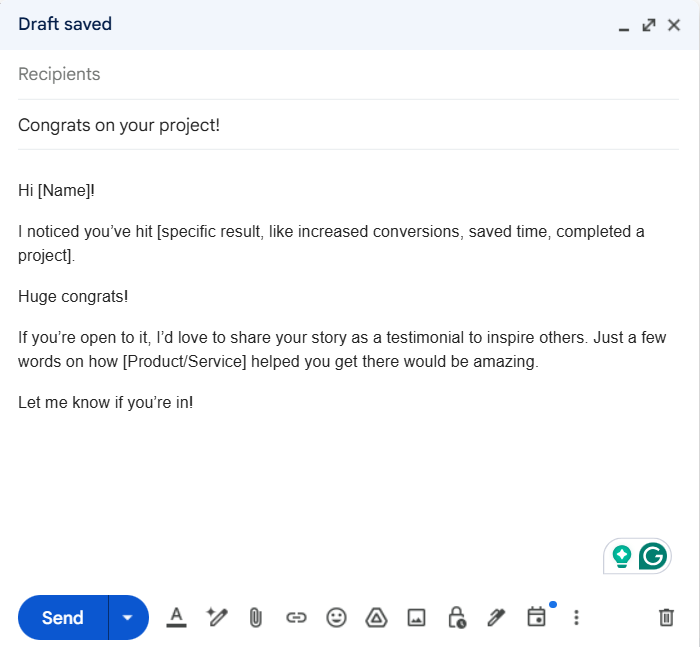
Best for:
Follow-ups after a purchase, onboarding completion, or hitting a key milestone.
Why it works:
People expect thoughtful asks in their inbox. You’ve got space to share context, offer examples, and even link to a form.
Try this:
Subject: Quick favor?
“Hey [Name], hope you’ve been loving [Product/Service]! If you're open to it, we’d be so grateful for a quick testimonial. Just a sentence or two about how it’s helped you would be amazing. No pressure, just whenever you’ve got a sec!”
2. SMS or Text
Best for:
Loyal customers, service-based clients, or post-support follow-ups, but only if you have their permission.
Why it works:
Quick, high open rates, and feels personal when done right.
Try this:
“Hey [Name]! Just wondering, would you be up for sharing a quick thought on how [Product] has been working for you? Nothing fancy, just a few words :)”
3. Social DMs (LinkedIn, Twitter, Instagram)
Best for:
When you've already had a casual conversation, seen them share praise, or want a less formal entry point.
Why it works:
Super conversational. Great for turning public praise into something you can share with permission.
Try this:
“Hey [Name], I saw your shoutout about [Product], thank you! Would you be cool with us turning that into a quick testimonial for our site? Happy to give you credit!”
4. In-Person or On-Call
Best for:
1:1 consulting, service-based work, or post-project check-ins.
Why it works:
You already have their attention, and the ask feels more genuine face-to-face (or Zoom-to-Zoom).
Try this:
“I’ve loved working with you on [project]! If you’re cool with it, would you be open to sharing a quick testimonial about how it went? Just a few words, nothing heavy!”
5. Pro Tip: Offer the Format, Not Just the Channel
Wherever you ask, let them choose how to respond, text, audio, or video. Some people love writing, others would rather hit record and speak freely. Giving that choice makes it way easier to say yes.
Now that you are done with all that, here are 10 Case Study Questions to Uncover Insights and Win Clients!
Which tools should you use to collect testimonials?
The good news: there are a bunch of tools that make it super easy for both you and your customers.
Here’s the lowdown on a few options, from simple forms to video tools.
1. Google Forms (or Typeform)
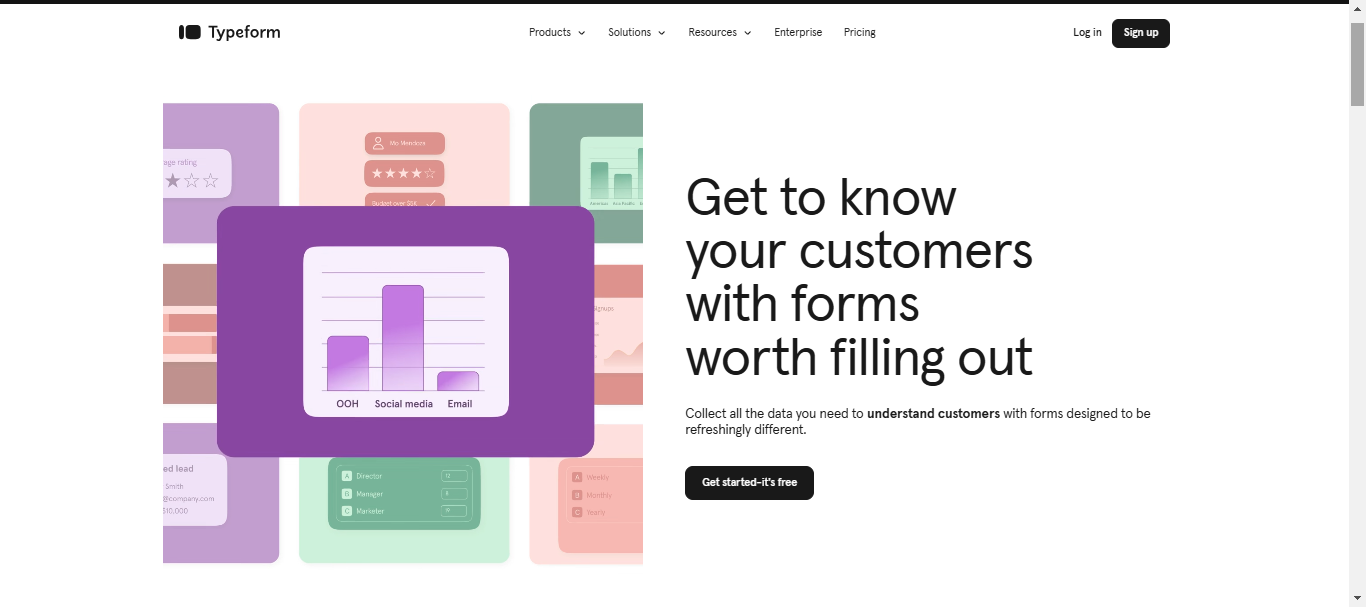
Sometimes, simple is best.
With Google Forms (free of charge, so your content marketing budget will thank you) or Typeform, you can create a quick, customizable form where customers can fill in their feedback. Just add a couple of easy prompts, hit “send,” and let them fill it out on their own time.
Why it’s great: It’s free, flexible, and lets you keep everything organized in one place. Plus, Typeform adds a little polish with a friendly, conversational feel.
2. VideoAsk (by Typeform)
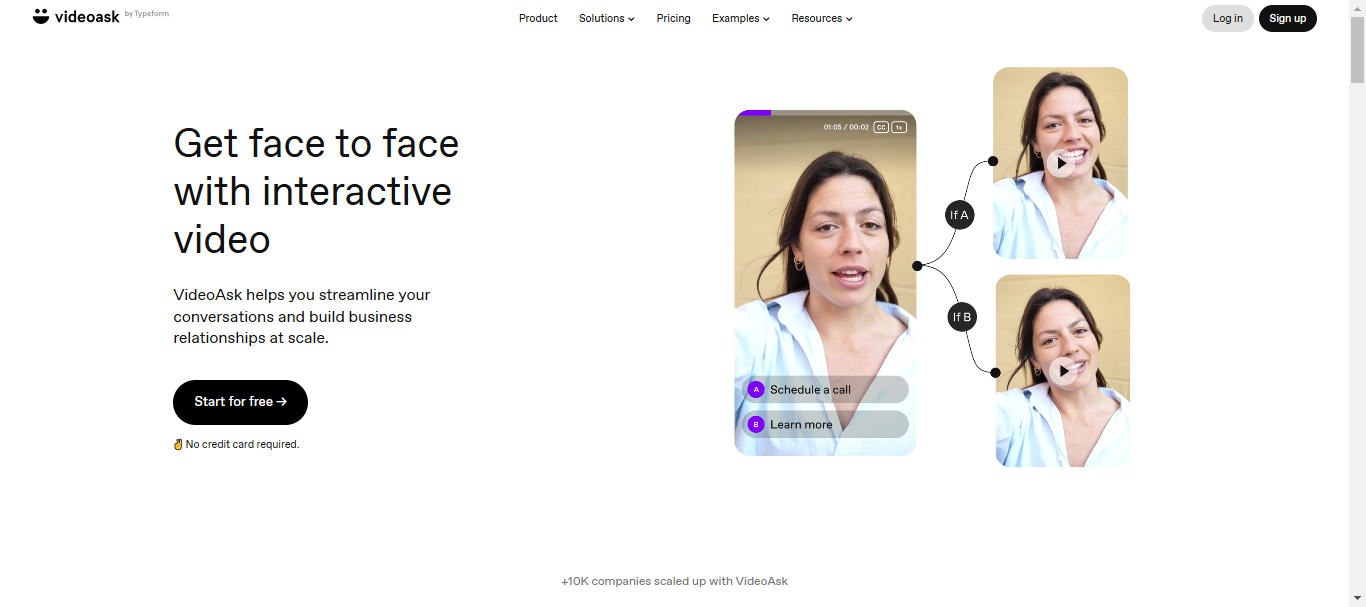
If you want video testimonials without the fuss, VideoAsk is a “game-changer”.
It lets you send users a simple link, and they can record a video right from their phone or laptop, no need to download anything!
Why it’s great: It’s personal, interactive, and super easy for customers. Video testimonials add a face and voice, which is powerful.
Plus, you can respond back (not with just a “please, please leave us a review” email), making it feel more like a conversation!
3. Trustpilot or G2 (for SaaS)
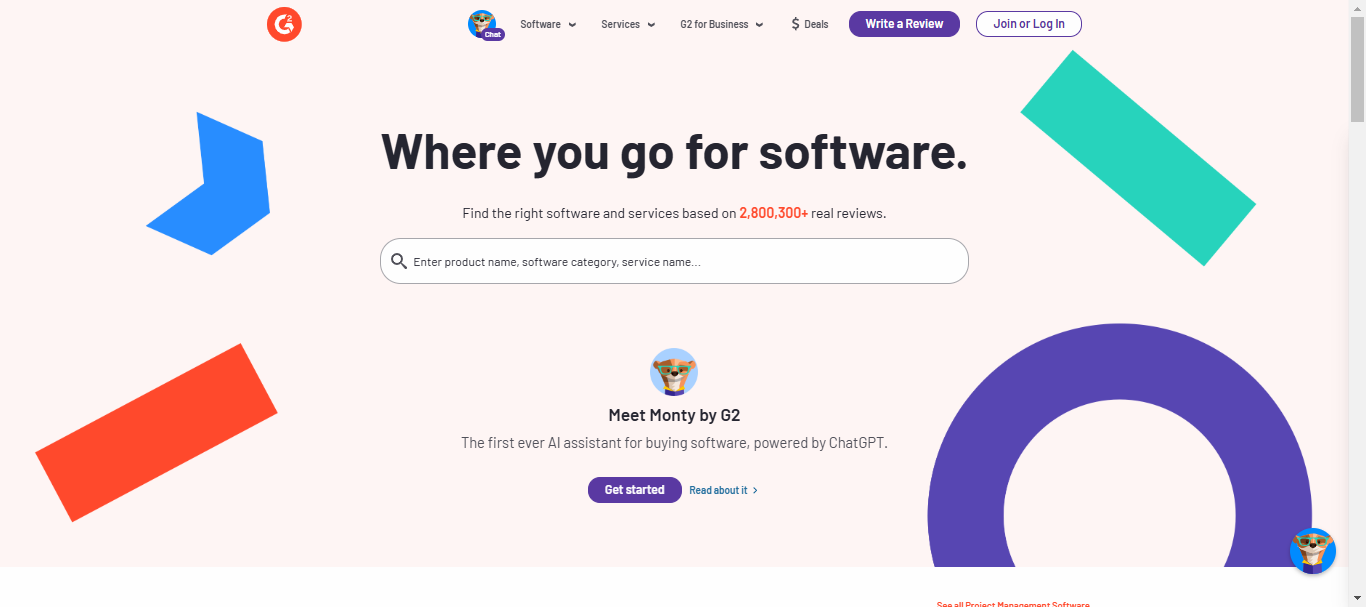
If you’re in SaaS or a similar industry, Trustpilot and G2 are big players. These platforms are where users often look to see what others are saying.
Ask your happy customers to leave a review there, and you’ll build credibility where it matters most.
Why it’s great: These sites are trusted by potential customers, and having positive reviews there boosts your product’s reputation. Plus, you can embed these testimonials directly on your site.
4. Senja
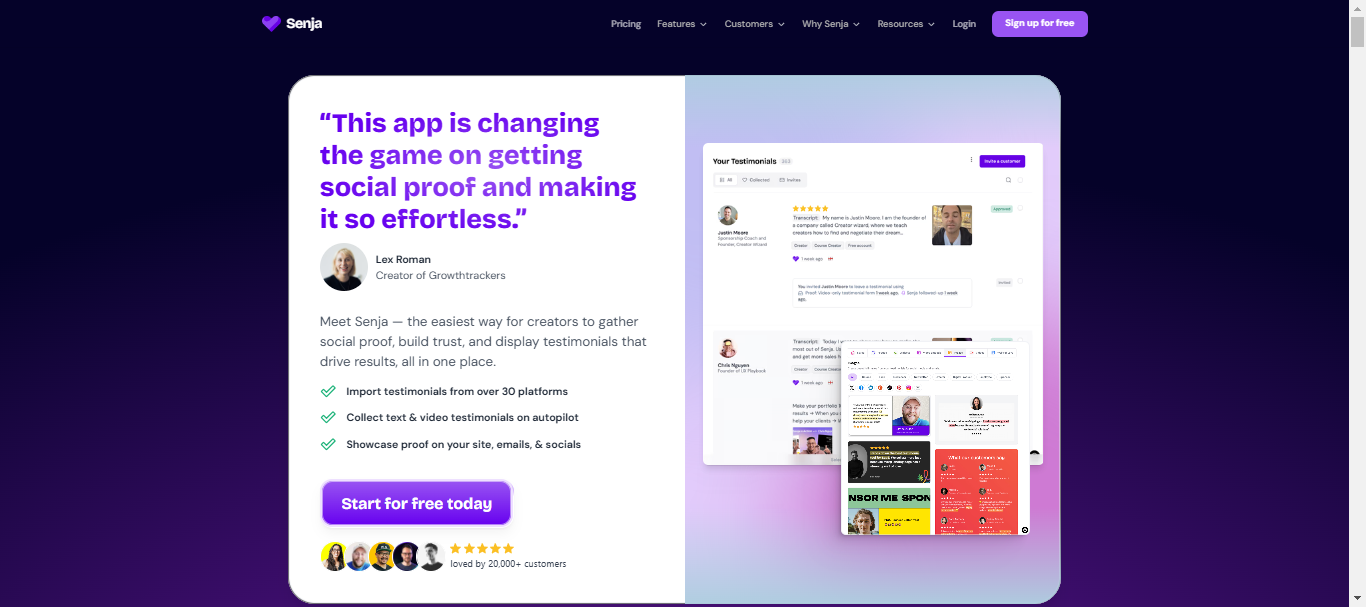
Senja is like a one-stop shop for collecting all types of testimonials, written, video, and even social proof from Twitter. It gives you a shareable link, and customers can leave their feedback in the format they prefer.
Why it’s great: It’s super easy for customers, and you get all your testimonials in one place. It’s also really easy to display them on your website, giving you an instant social proof boost.
So, which one to pick?
Think about what fits your style and needs best!
-
If you want simple, go with Google Forms.
-
Want that extra polish? Try Senja.
-
And if video is your thing, VideoAsk is a no-brainer.
-
And for a done-for-you case study, SaaSpirin is your best bet!
Each tool adds a little something different, so test them out and see which one makes your testimonial collection process easy and fun for both you and your customers.
Go out and get those testimonials!
Alright, you’re ready with everything we know about how to ask for a testimonial!
You’ve got the timing, the how to ask for a testimonial from a client template, the tools, and all the tips to make asking for testimonials feel natural and easy. Now it’s time to put it into action.
Don’t be shy!
Reach out, be friendly, and remember: people love sharing positive testimonials of their positive experiences, especially if you make it simple for them.
The best part? These testimonials aren’t just nice words; they’re powerful, genuine proof that helps future customers feel confident choosing you. Each testimonial is like a little spark that builds trust and shows the real impact of what you offer.
So, go get those testimonials!
Show the world what your customers love about you. And most importantly, enjoy the process. It’s not just about building credibility, it’s about building connections with the people who make your business shine.
Psss…Ready to take it a step further?
Case studies are our thing, and we’d love to help you bring those client stories to life. Let us show you how easy (and fun!) it can be with our DFY service.
Share on X Share on Facebook Share on LinkedIn
Frequently Asked Questions
1. What’s the best way to send a testimonial request email that actually gets a response?
Use friendly, personalized testimonial email templates that include the client's name, a clear ask, and a link to a testimonial form. Tools like email automation make this scalable without losing the human touch.
2. How can I use email marketing to collect more client testimonials?
Your email list is a goldmine for gathering testimonials. A simple, well-timed testimonial request email to new customers or repeat buyers can be a great way to capture fresh feedback.
3. Should I follow up if a client hasn’t sent their testimonial yet?
Yes, politely following up after giving them enough time shows you care without pushing. A second email, gentle text message, or even a quick social media post DM can be effective. A good testimonial form should guide clients with a set of questions.
4. What should I include in my testimonial form?
A good testimonial form should guide clients with a set of questions that help them reflect on their customer experience, what they loved, what stood out, and what changed for them.
5. Can I ask for testimonials through text messages?
Definitely. Text messages can be super effective, just keep them brief, respectful, and ideally only use them if your client has opted in. Include a link to your testimonial form to make it easy.
6. How do I use testimonials to boost my marketing efforts?
Add testimonials to your testimonial page, product pages, and even in email marketing campaigns. They help turn online reviews into compelling proof of your brand’s impact.
7. Is there a starting point if I’ve never collected testimonials before?
Start small. Use simple testimonial email templates or a basic feedback form to reach out to satisfied clients. It’s a great way to dip your toes in and refine your process.
8. What’s the role of customer service in collecting testimonials?
Strong customer service creates the positive experiences that drive powerful testimonials. Your support team can also help identify happy clients and share a timely testimonial request email on your behalf.
9. How do I handle constructive feedback instead of a glowing testimonial?
If you receive constructive feedback, thank the client and treat it as a chance to improve. You can even ask for permission to share their comments if they highlight a before-and-after transformation.
10. Can testimonials from happy clients replace online reviews?
Not exactly, but they work hand in hand. Online reviews help you build public credibility, while curated testimonials can be embedded in emails, websites, and social media posts to drive conversions
You May Also Like
These Related Stories
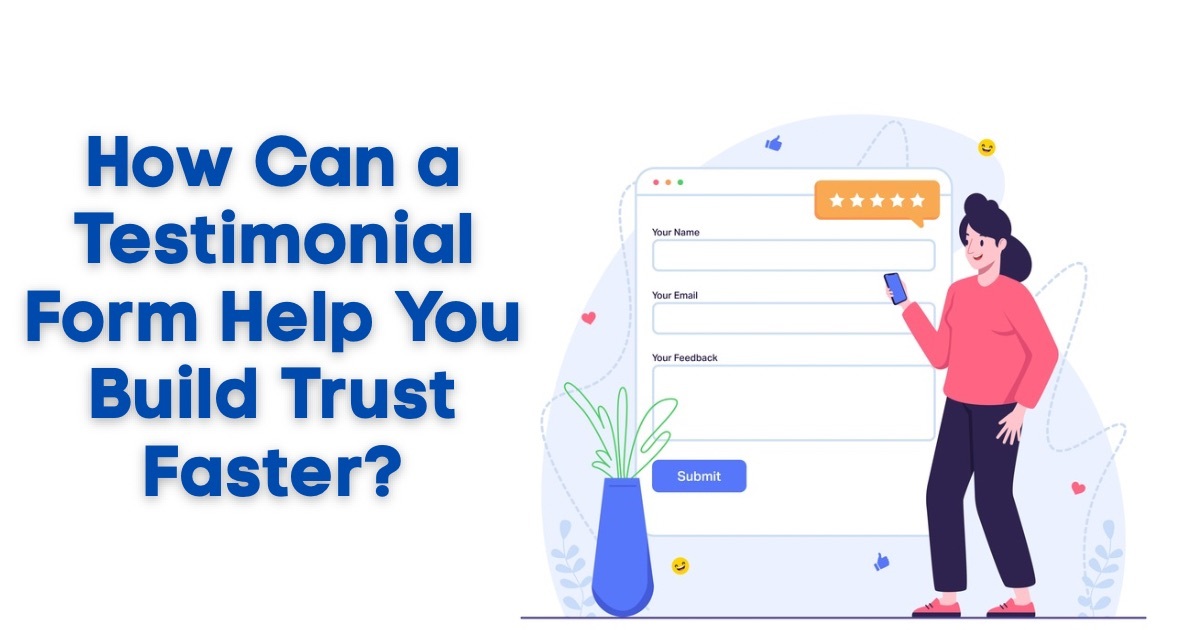
How Can a Testimonial Form Help You Build Trust Faster?
.png)
